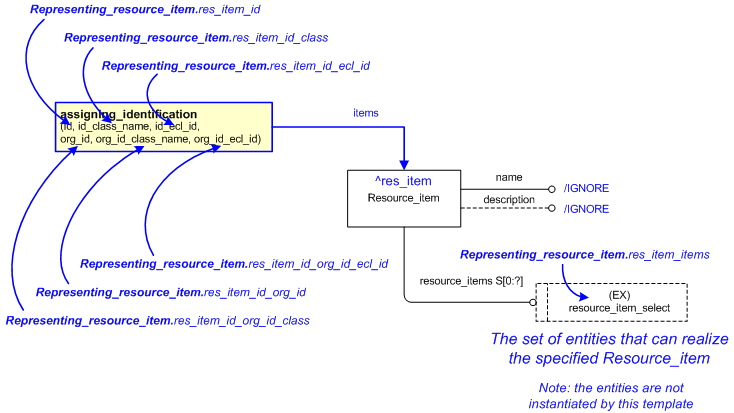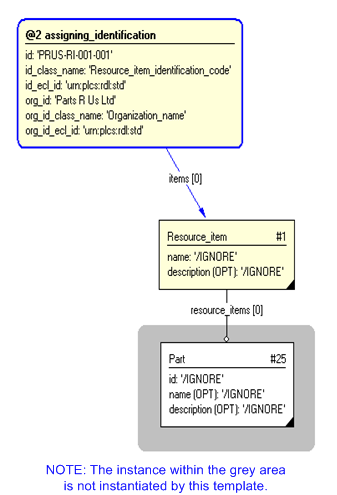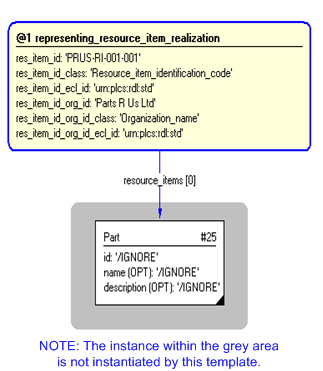| Template:— representing_resource_item_realization (rep_res_item_real) |
Date: 2008/02/26 19:03:42
Revision: 1.8
|
This section specifies the template representing_resource_item_realization.
NOTE
An explanation of a template and the associated instantiation path is
provided in the
Template overview
section.
This template describes how to represent the realization of a resource item, where the resource item is used as a placeholder
for the
object that the resource item may refer to.
NOTE
The resource item under consideration shall already exist in the data set, and been created
in accordance with the template representing_resource_item.
NOTE
The reference parameter defined within this template shall not be used ouside the scope of this template,
i.e. the reference parameter shall be regarded as being 'private' to this template.
This is due to that entity instances being used in this template already exists
and can be referenced using reference parameters in other templates.
The EXPRESS-G diagram in
Figure
1
shows the templates and EXPRESS entities that are required
to represent the template
"representing_resource_item_realization".
The text highlighted in blue shows the template parameters.
Figure 1 — An EXPRESS-G representation of the Information model for representing_resource_item_realization
The graphic for the template to be used in other EXPRESS-G diagrams
is shown in Figure
2
below.
Figure 2 — The graphical representation of the representing_resource_item_realization template
The following input parameters are defined for this template:
The type of identifier (@res_item_id) being referenced
The following classes and their sub-classes can be used:
The following classes and their sub-classes can be used:
The id of the
External_class_library storing the
definition of the class used to classify the organization identifier.
Item that shall be added to the SET of resource items that realizes the resource item under consideration.
The following reference parameters are defined for this template:
Allow the
Resource_item
entity instantiated in this path to be referenced when this template is used.
Note: The
Resource_item
entity can be referenced in a template path by:
%^target = $representing_resource_item_realization.res_item%
where
target
is the parameter to which the
Resource_item
is bound.
The instantiation path shown below specifies the entities that are to be
instantiated by the template.
The following entities are instantiated with attributes as specified:
The instance diagram in Figure
3
shows an example of the EXPRESS entities and templates that are instantiated by the template:
/representing_resource_item_realization(res_item_id='PRUS-RI-001-001', res_item_id_class='Resource_item_identification_code', res_item_id_ecl_id='urn:plcs:rdl:std', res_item_id_org_id='Parts R Us Ltd', res_item_id_org_id_class='Organization_name', res_item_id_org_id_ecl_id='urn:plcs:rdl:std', res_item_items='#1')/
(an illustration of the consolidated representing_resource_item_realization template is shown in
Figure
4 below.)
Figure 3 — Entities and templates used by representing_resource_item_realization template
The instance model in STEP ASCII exchange file format (ISO 10303 Part
21 syntax) is:
#1 = RESOURCE_ITEM('/IGNORE','/IGNORE',(#25));
#3 = IDENTIFICATION_ASSIGNMENT('PRUS-RI-001-001','/IGNORE',$,(#1));
#5 = CLASSIFICATION_ASSIGNMENT(#7,(#3),'/IGNORE');
#7 = EXTERNAL_CLASS('/NULL','Resource_item_identification_code','/IGNORE',#8);
#8 = EXTERNAL_CLASS_LIBRARY('urn:plcs:rdl:std',$);
#10 = ORGANIZATION('/IGNORE','/IGNORE');
#12 = IDENTIFICATION_ASSIGNMENT('Parts R Us Ltd','/IGNORE','/IGNORE',(#10));
#14 = CLASSIFICATION_ASSIGNMENT(#16,(#12),'/IGNORE');
#16 = EXTERNAL_CLASS('/NULL','Organization_name','/IGNORE',#8);
#18 = ORGANIZATION_OR_PERSON_IN_ORGANIZATION_ASSIGNMENT(#10,'/IGNORE',(#3));
#20 = CLASSIFICATION_ASSIGNMENT(#22,(#18),'/IGNORE');
#22 = EXTERNAL_CLASS('/NULL','Owner_of','/IGNORE',#8);
#25 = PART('/IGNORE','/IGNORE','/IGNORE');
The instance diagram in
Figure
4
shows the graphic symbol for the template that is to be
used in other instance diagrams. The example template is:
/representing_resource_item_realization(res_item_id='PRUS-RI-001-001', res_item_id_class='Resource_item_identification_code', res_item_id_ecl_id='urn:plcs:rdl:std', res_item_id_org_id='Parts R Us Ltd', res_item_id_org_id_class='Organization_name', res_item_id_org_id_ecl_id='urn:plcs:rdl:std', res_item_items='#1')/
Figure 4 — Instantiation of representing_resource_item_realization template
Characterizations
No common characterizations of the template
representing_resource_item_realization
have been identified. However, the ISO 10303-239 EXPRESS model
may enable other assignments to the entities instantiated by the template.




